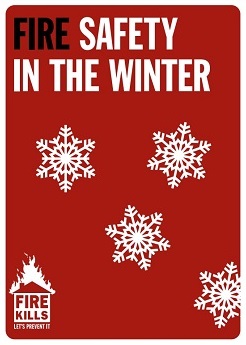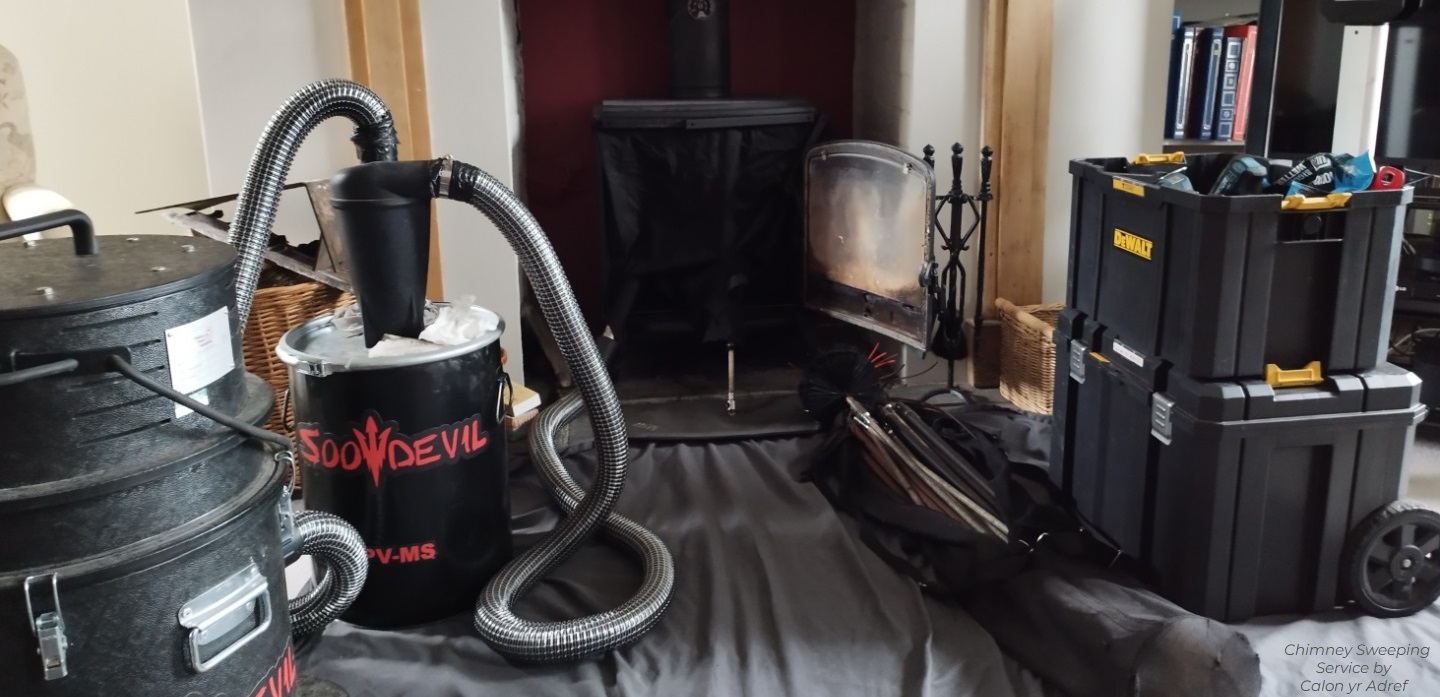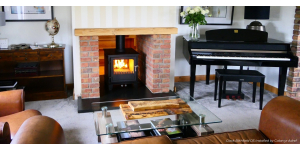Does my chimney need sweeping?
Chimney sweeping is extremely important. It prevents chimney fires and carbon monoxide poisoning.
If you have or intend to use your fireplace to burn wood or solid fuel, if the chimney hasn’t been swept in the last 12 months and/or if you’re unsure of when it was swept last, then the answer is yes! For many people, their first thought upon the mention of chimney sweeping is to associate the profession with Mary Poppins, Father Christmas and Victorian times. Although the following facts stand true, that Mary Poppins is undoubtedly a classic, Father Christmas prefers to enter a clean chimney and we’re grateful to be sweeps in the 21st Century as opposed to Victorian times - all jokes aside, chimney sweeping must not be downplayed as a non-serious trade. Chimney Sweeping prevents chimney fires and carbon monoxide poisoning, saving lives.

According to government data in this .gov ‘Fire Safety in the Winter’ Leaflet linked here:
3800 Chimney fires occur in England each year.
According to government fire and rescue incident statistics for Wales, from 2021-2022, 333 chimney fires were reported.
With the energy crisis caused by surge of wholesale fuel prices and increased cost of living experienced in the UK through 2023, many people have opted to re-commission old fireplaces and chimneys to bring down their heating costs. It is not unreasonable to anticipate an increase in these incidents whereby annual servicing is not carried out and where stoves have been installed by inexperienced DIY’ers, unaware of all the safety measures involved with safe installation. With annual maintenance, chimney fires are absolutely preventable. Chimney fires damage chimney systems making them unsafe for use. At worst chimney fires cause house fires, when the fire spreads.. Although some have been lucky with their insurance policies, most will have great difficulty in receiving compensation without having documentation to evidence that the appliance is safe to use and the chimney has been regularly swept. Upon the completion of the chimney sweep, we issue insurance-recognised certification, which is a requirement of most insurance policies for properties with solid fuel and wood burning appliances.
Another important factor of Chimney sweeping is to prevent carbon monoxide (CO) poisoning.
Carbon Monoxide is odourless and is undetectable without an alarm. When a flue is not maintained, over time the soot build up reduces the diameter of the flue. As a result, eventually, the flue will become narrowed, whereby the smoke will escape but the carbon monoxide can travel back down the flue and enter into the room. Over time with low exposure, or in a short amount of time with high exposure, CO reaches dangerous levels in the bloodstream and when not identified and treated, leads to death. Carbon monoxide is bound in the blood by haemoglobin 200-300 times stronger than Oxygen. With haemoglobin favouring carbon monoxide over oxygen, it leaves fewer and fewer binding sites for oxygen within the blood. This means that when you breathe in carbon monoxide, your red blood cells will absorb the carbon monoxide before it absorbs oxygen, and once fully saturated will then be unable to carry any oxygen at all, starving your vital organs of the oxygen they need to function. It’s this process which leads to poisoning and death. Like chimney fires, CO poisonings resulting from the use of unmaintained flue systems are completely preventable by regular servicing. In our time sweeping, we have directly and indirectly prevented carbon monoxide poisoning.
To read more about my personal experiences preventing carbon monoxide poisoning, click here.
Why do I need my chimney sweeping?
The main reason to get your chimney swept is to remove unburnt hydrocarbons. Through the process of combustion, when incomplete combustion occurs, these unburnt hydrocarbons are left behind in the flue. This is soot. With the combustion temperature of soot being lower than paper, and with soot built-up in the flue way - this poses a very real fire risk. By leaving the chimney unswept for prolonged periods, you are leaving yourself open to the risk of a chimney fire. Secondly, this soot will over time, reduce the diameter of the flue. As a result, eventually the flue will become narrowed, whereby the smoke will escape but the carbon monoxide (CO) can travel back down the flue. To prevent chimney fires and carbon monoxide poisoning, it is advisable to get your chimney swept at least once annually. With the way soot coats the flue way and reduces its diameter, by this process the soot build-up in the chimney will eventually lead to the fire not drawing adequately, which will affect the function of the appliance. If your stove or fireplace starts smoking back despite stable weather conditions, this usually indicates the flue is overdue a sweep and this should be done as soon as possible, before continued use of the appliance. Our technicians are clued up on safely and efficiently heating your home with wood or solid fuel and are always on hand to advise and answer any queries you may have.
Fault diagnosis
If your fire is smoking back this could be caused by a few things. It could be that you’re inexperienced in using your appliance correctly. You may need to open the air vents on the stove before refuelling. You may need to open the door a touch to allow the stove to depressurise before opening the door fully. It may be that you're burning wood which isn’t dry enough. Many people who go from open fires to wood burners make this mistake. Open fires pull a huge amount of additional oxygen which increases combustion and is why they are 80% inefficient vs the potential 80%+ efficiency of a modern woodburner. With the extra oxygen and size of an open chimney system of an open fire, it is possible to get away with burning wood which you would otherwise have great difficulty burning on a modern and efficient woodburner which requires the wood to be below 20% (ideally below 15%) moisture. If the chimney hasn’t been swept in a longtime, the smoking back could be due to a build up of soot. It could be that the flue isn’t tall enough. It could be due to the location of your property and prevailing winds. It could be that a tree next to the property has grown really tall or dense and is now affecting the pressures around the top of the flue. It could be particularly windy weather whereby the wind is blowing in a direction it doesn’t usually. It could be that the chimney needs a different type of terminal to help with updraught or prevent downdraught. It could be that the stove is ineffective. It could be that in the process of combustion, the stove is pulling more air than it can get from the room and it needs a dedicated air vent.
It’s usually one or two of the above. There is a little bit of knowledge and know-how when it comes to getting the best out of your appliance. Our chimney sweeping team is clued up on all areas of fault diagnosis.
How often should I get my chimney swept?
For wood burning - once a year is recommended and for solid fuel, twice a year. It is a legal requirement for tenanted properties, holiday lets and the likes. We carry out the servicing schedule for the county council and a local housing association every 6 months and most of our private customers are done once a year. Many of these properties still rely on their solid fuel appliance as their primary heating source. With these appliances kept-in virtually all year round, it is imperative that we service them every 6 months, whereby we remove a considerable amount of soot each time, keeping the flue way operational and safe. Some of our customers who seldom use their stove or are burning incredibly dry wood and/or are achieving almost complete combustion on exceptionally modern clean burning stoves can get away with having it done at longer intervals, although most opt to have it done annually in order to maintain a consistent servicing record for insurance and warranty purposes. So how often should I get my chimney swept? The short answer is at least once a year, however, the frequency required is ultimately dependent on the amount of use the appliance gets, how the appliance is used as well as the fuel used.
Is chimney sweeping a legal requirement?
Under Section 11 of the Landlord and Tenant Act 1985, the Landlord is legally responsible (unless otherwise stated in the tenancy agreement) for ensuring the safety, working and servicing of all heating and hot water installations. Although the wording can seem ambiguous, this also refers to open fires, Rayburns, Agas, coal and wood-burning stoves.
For Solid Fuel appliances, it is recommended to have the chimney swept twice a year and for wood-burning appliances once a year.
CO (carbon monoxide) alarms are another legal requirement. Under the Renting Homes (Wales) Act 2016, part two states that the landlord must Install carbon monoxide alarms where a gas, oil or solid fuel appliance is present.



